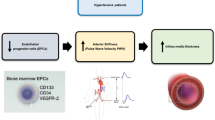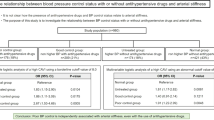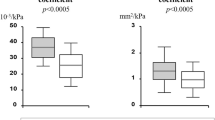Abstract
Inflammation has been shown to play a pivotal role in the pathogenesis and development of hypertensive vascular injury. Neopterin is a novel marker of immune activation produced mainly by activated macrophages. Few data are available to show the association between neopterin and vascular function in hypertension. The present study was designed to investigate the relationship between neopterin levels related to arterial stiffness and endothelial function in patients with hypertension, and their changes after blood pressure-lowering treatment. Twenty-four hypertensive patients and 30 age- and gender-matched healthy volunteers were recruited. Plasma neopterin levels were higher in hypertensive patients compared with their counterparts (log-neopterin: 0.77±0.18 versus 0.61±0.16, P=0.003). Increased neopterin levels were correlated with increased brachial-ankle pulse wave velocity (baPWV; control: r=0.659, P<0.001; hypertension: r=0.487, P=0.021), and inversely associated with impaired brachial flow-mediated dilation (FMD; control: r=−0.735, P<0.001; hypertension: r=−0.557, P=0.005). Fifteen hypertensives received 3 months of standard antihypertensive treatment. Three months later, their plasma neopterin levels decreased (log-neopterin: 0.63±0.17 versus 0.50±0.19, P=0.001), whereas arterial elasticity (baPWV: 1764±101 versus 1685±96 cm s−1, P=0.272) and endothelial function (FMD: 5.92±1.43% versus 7.73±1.31%, P<0.05) were improved. The decline in neopterin levels was linearly correlated with baPWV decrease (r=0.800, P<0.001), FMD improvement (r=0.670, P=0.006) and blood pressure reduction (r=0.548, P=0.042). Our present study demonstrated for the first time that neopterin is closely correlated with vascular dysfunctions, and measurement of plasma neopterin levels might be used as a surrogate biomarker for the clinical evaluation of vascular damage and risk stratification of future atherosclerotic cardiovascular disease in patients with hypertension.
This is a preview of subscription content, access via your institution
Access options
Subscribe to this journal
Receive 12 digital issues and online access to articles
$119.00 per year
only $9.92 per issue
Buy this article
- Purchase on Springer Link
- Instant access to full article PDF
Prices may be subject to local taxes which are calculated during checkout




Similar content being viewed by others
References
Takashima N, Turin TC, Matsui K, Rumana N, Nakamura Y, Kadota A et al. The relationship of brachial-ankle pulse wave velocity to future cardiovascular disease events in the general Japanese population: the Takashima Study. J Hum Hypertens 2014; 28: 323–327.
Yang Y, Xu JZ, Wang Y, Tang XF, Gao PJ . Brachial flow-mediated dilation predicts subclinical target organ damage progression in essential hypertensive patients: a 3-year follow-up study. J Hypertens 2014; 32: 2393–2400.
Bianchini E, Giannarelli C, Bruno RM, Armenia S, Landini L, Faita F et al. Functional and structural alterations of large arteries: methodological issues. Curr Pharm Des 2013; 19: 2390–2400.
Ross R . Atherosclerosis—an inflammatory disease. N Engl J Med 1999; 340: 115–126.
Ridker PM, Cushman M, Stampfer MJ, Tracy RP, Hennekens CH . Inflammation, aspirin, and the risk of cardiovascular disease in apparently healthy men. N Engl J Med 1997; 336: 973–979.
Buffon A, Biasucci LM, Liuzzo G, D’Onofrio G, Crea F, Maseri A . Widespread coronary inflammation in patients with unstable angina. N Engl J Med 2002; 347: 5–12.
Spagnoli LG, Bonanno E, Mauriello A, Palmieri G, Partenzi A, Sangiorgi G et al. Multicentric inflammation in epicardial coronary arteries of patients dying of acute myocardial infarction. J Am Coll Cardiol 2002; 40: 1579–1588.
Huber C, Batchelor JR, Fuchs D, Hausen A, Lang A, Niederwieser D et al. Immune response-associated production of neopterin. Release from macrophages primarily under control of interferon-gamma. J Exp Med 1984; 160: 310–316.
Schumacher M, Halwachs G, Tatzber F, Fruhwald FM, Zweiker R, Watzinger N et al. Increased neopterin in patients with chronic and acute coronary syndromes. J Am Coll Cardiol 1997; 30: 703–707.
Avanzas P, Arroyo-Espliguero R, Quiles J, Roy D, Kaski JC . Elevated serum neopterin predicts adverse cardiac events in patients with chronic stable angina pectoris. Eur Heart J 2005; 26: 457–463.
Kaski JC, Consuegra-Sanchez L, Fernandez-Berges DJ, Cruz-Fernandez JM, Garcia-Moll X, Marrugat J et al. Elevated serum neopterin levels and adverse cardiac events at 6 months follow-up in Mediterranean patients with non-ST-segment elevation acute coronary syndrome. Atherosclerosis 2008; 201: 176–183.
Avanzas P, Arroyo-Espliguero R, Cosin-Sales J, Quiles J, Zouridakis E, Kaski JC . Prognostic value of neopterin levels in treated patients with hypertension and chest pain but without obstructive coronary artery disease. Am J Cardiol 2004; 93: 627–629.
Munakata M, Ito N, Nunokawa T, Yoshinaga K . Utility of automated brachial ankle pulse wave velocity measurements in hypertensive patients. Am J Hypertens 2003; 16: 653–657.
Wang JM, Su C, Wang Y, Huang YJ, Yang Z, Chen L et al. Elevated circulating endothelial microparticles and brachial-ankle pulse wave velocity in well-controlled hypertensive patients. J Hum Hypertens 2009; 23: 307–315.
Corretti MC, Anderson TJ, Benjamin EJ, Celermajer D, Charbonneau F, Creager MA et al. Guidelines for the ultrasound assessment of endothelial-dependent flow-mediated vasodilation of the brachial artery: a report of the International Brachial Artery Reactivity Task Force. J Am Coll Cardiol 2002; 39: 257–265.
Tao J, Liu DH, Wang LC, Wang JM, Yang Z, Lou ZF et al. Arterial elasticity identified by pulse wave analysis and its relation to endothelial function in patients with coronary artery disease. J Hum Hypertens 2007; 21: 149–153.
Behrendt D, Ganz P . Endothelial function. From vascular biology to clinical applications. Am J Cardiol 2002; 90: 40L–48L.
Raitakari OT, Celermajer DS . Flow-mediated dilatation. Br J Clin Pharmacol 2000; 50: 397–404.
Stehouwer CD, Gall MA, Twisk JW, Knudsen E, Emeis JJ, Parving HH . Increased urinary albumin excretion, endothelial dysfunction, and chronic low-grade inflammation in type 2 diabetes: progressive, interrelated, and independently associated with risk of death. Diabetes 2002; 51: 1157–1165.
Cirillo P, Pacileo M, De Rosa S, Calabro P, Gargiulo A, Angri V et al. Neopterin induces pro-atherothrombotic phenotype in human coronary endothelial cells. J Thromb Haemost 2006; 4: 2248–2255.
Stehouwer CD, Henry RM, Ferreira I . Arterial stiffness in diabetes and the metabolic syndrome: a pathway to cardiovascular diseases. Diabetologia 2008; 51: 527–539.
Laurent S, Cockcroft J, Van Bortel L, Boutouyrie P, Giannattasio C, Hayoz D et al. European network for non-invasive investigation of large arteries. Expert consensus document on arterial stiffness: methodological issues and clinical applications. Eur Heart J 2006; 27: 2588–2605.
Sheng CS, Li Y, Li LH, Huang QF, Zeng WF, Kang YY et al. Brachial-ankle pulse wave velocity as a predictor of mortality in elderly Chinese. Hypertension 2014; 64: 1124–1130.
Munakata M, Konno S, Miura Y, Yoshinaga K and J-TOPP Study Group. Prognostic significance of the brachial-ankle pulse wave velocity in patients with essential hypertension: final results of the J-TOPP study. Hypertens Res 2012; 35: 839–842.
Acknowledgements
This work was supported by 973 Program (2013CB531200), the National Nature Science Foundation (31370941) and Provincial Guidance University-industry Cooperation Projects (302011B090400058) of China.
Author information
Authors and Affiliations
Corresponding author
Ethics declarations
Competing interests
The authors declare no conflict of interest.
Rights and permissions
About this article
Cite this article
Zhang, YY., Tong, XZ., Xia, WH. et al. Increased plasma neopterin levels are associated with reduced endothelial function and arterial elasticity in hypertension. J Hum Hypertens 30, 436–441 (2016). https://doi.org/10.1038/jhh.2015.72
Received:
Revised:
Accepted:
Published:
Issue Date:
DOI: https://doi.org/10.1038/jhh.2015.72
This article is cited by
-
Inflammation, sex, blood pressure changes and hypertension in midlife: the Hordaland Health Study
Journal of Human Hypertension (2022)
-
Changes in C-reactive protein, neopterin and lactoferrin differ after conservative and surgical weight loss in individuals with morbid obesity
Scientific Reports (2019)



